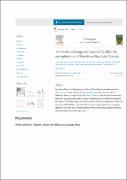| dc.contributor.author | Luyiga, Suzan | |
| dc.contributor.author | Haande, Sigrid | |
| dc.contributor.author | Semyalo, Ronald P. | |
| dc.contributor.author | Kizito, Yusuf S. | |
| dc.contributor.author | Miyingo-Kezimbira, Anne | |
| dc.contributor.author | Brettum, Pål | |
| dc.contributor.author | Solheim, Anne Lyche | |
| dc.contributor.author | Odong, Robinson | |
| dc.contributor.author | Asio, Santa Maria | |
| dc.contributor.author | Jensen, Knut Helge | |
| dc.contributor.author | Larsson, Petter | |
| dc.date.accessioned | 2022-03-03T12:57:19Z | |
| dc.date.available | 2022-03-03T12:57:19Z | |
| dc.date.issued | 2015-07 | |
| dc.identifier.citation | Luyiga, Suzan...et al (2015). How water exchange and seasonality affect the eutrophication of Murchison bay, lake Victoria.Elsevier: Limnologica. https://doi.org/10.1016/j.limno.2015.06.001. | en_US |
| dc.identifier.uri | https://doi.org/10.1016/j.limno.2015.06.001 | |
| dc.identifier.uri | https://kyuspace.kyu.ac.ug/xmlui/handle/20.500.12504/769 | |
| dc.description | 60-73 p. | en_US |
| dc.description.abstract | Murchison Bay in the Northern part of Lake Victoria has for decades received a daily wastewater load of 0.2% of its volume from Kampala City, through the Nakivubo channel. In spite of this, the Water Treatment Works abstracts raw water from this bay and has been able to produce drinking water of sufficient quality for the capital. This study monitored various physical−chemical components within the bay during 2000−2003 to understand the processes responsible for the acceptable quality of raw water. Four sampling stations were located along a transect from the channel mouth towards the open lake.
Results
showed that the wastewater did not accumulate in the bay, instead was already strongly diluted 2.5 km from the channel mouth. This caused an abrupt reduction in conductivity and the concentrations of the nutrients total phosphorus (Tot-P), orthophosphate (PO4-P) and total nitrogen (Tot-N).
Inshore−offshore exchange of water was mediated by flows from daily and sub-daily water level fluctuations and wind-driven currents. As a daily average, 2% of the Murchison Bay flowed in and out and the incoming wastewater was diluted 9.7 times.
During the dry season from June to August (D2), when the weather was influenced by the south-east monsoon, the thermal stratification in the main lake disappeared and cooler and deoxygenated water from deeper depths entered the bay influencing its water quality.
The daily flushing of water in and out of the bay due to water level variation was identified as the main factor diluting the bay water. | en_US |
| dc.language.iso | en | en_US |
| dc.publisher | Elsevier: Limnologica | en_US |
| dc.relation.ispartofseries | Vol.53; | |
| dc.subject | Water pollution | en_US |
| dc.subject | Seiches | en_US |
| dc.subject | Water level fluctuations | en_US |
| dc.subject | Large lakes | en_US |
| dc.title | How water exchange and seasonality affect the eutrophication of Murchison bay, lake Victoria | en_US |
| dc.type | Article | en_US |

